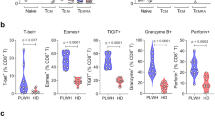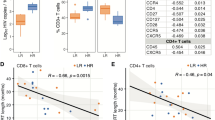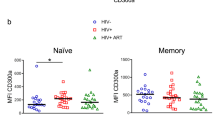Abstract
It is unclear why immunological control of HIV replication is incomplete in most infected individuals. We examined here the CD8+ T cell response to HIV-infected CD4+ T cells in rare patients with immunological control of HIV. Although high frequencies of HIV-specific CD8+ T cells were present in nonprogressors and progressors, only those of nonprogressors maintained a high proliferative capacity. This proliferation was coupled to increases in perforin expression. These results indicated that nonprogressors were differentiated by increased proliferative capacity of HIV-specific CD8+ T cells linked to enhanced effector function. In addition, the relative absence of these functions in progressors may represent a mechanism by which HIV avoids immunological control.
This is a preview of subscription content, access via your institution
Access options
Subscribe to this journal
Receive 12 print issues and online access
$209.00 per year
only $17.42 per issue
Buy this article
- Purchase on Springer Link
- Instant access to full article PDF
Prices may be subject to local taxes which are calculated during checkout





Similar content being viewed by others
References
McMichael, A.J. & Rowland-Jones, S.L. Cellular immune responses to HIV. Nature 410, 980–987 (2001).
Lieberman, J., Shankar, P., Manjunath, N. & Andersson, J. Dressed to kill? A review of why antiviral CD8 T lymphocytes fail to prevent progressive immunodeficiency in HIV-1 infection. Blood 98, 1667–1677 (2001).
Goulder, P.J. et al. Novel, cross-restricted, conserved, and immunodominant cytotoxic T lymphocyte epitopes in slow progressors in HIV type 1 infection. AIDS Res. Hum. Retroviruses 12, 1691–1698 (1996).
Kaslow, R.A. et al. Influence of combinations of human major histocompatibility complex genes on the course of HIV-1 infection. Nature Med. 2, 405–411 (1996).
Carrington, M. et al. HLA and HIV-1: heterozygote advantage and B*35-Cw*04 disadvantage. Science 283, 1748–1752 (1999).
Flores-Villanueva, P.O. et al. Control of HIV-1 viremia and protection from AIDS are associated with HLA-Bw4 homozygosity. Proc. Natl. Acad. Sci. USA 98, 5140–5145 (2001).
Migueles, S.A. et al. HLA B*5701 is highly associated with restriction of virus replication in a subgroup of HIV-infected long term nonprogressors. Proc. Natl. Acad. Sci. USA. 97, 2709–2714 (2000).
Migueles, S.A. & Connors, M. Frequency and function of HIV-specific CD8+ T cells. Immunol. Lett. 79, 141–150 (2001).
Gea-Banacloche, J.C. et al. Maintenance of large numbers of virus specific CD8+ T cells in HIV infected progressors and long term nonprogressors. J. Immunol. 165, 1082–1092 (2000).
Dalod, M. et al. Broad, intense anti-human immunodeficiency virus (HIV) ex vivo CD8+ responses in HIV type 1-infected patients: comparison with anti-Epstein-Barr virus responses and changes during antiretroviral therapy. J. Virol. 73, 7108–7116 (1999).
Betts, M.R. et al. Analysis of total human immunodeficiency virus (HIV)-specific CD4+ and CD8+ T-cell responses: relationship to viral load in untreated HIV infection. J. Virol. 75, 11983–11991 (2001).
Kostense, S. et al. Persistent numbers of tetramer+ CD8+ T cells, but loss of interferon-γ+ HIV-specific T cells during progression to AIDS. Blood 99, 2505–2511 (2002).
Pantaleo, G. et al. Studies in subjects with long-term nonprogressive human immunodeficiency virus infection. N. Engl. J. Med. 332, 209–216 (1995).
Strathdee, S.A. et al. Lack of consistency between five definitions of nonprogression in cohorts of HIV-infected seroconverters. AIDS 10, 959–965 (1996).
Oxenius, A. et al. Distribution of functional HIV-specific CD8 T lymphocytes between blood and secondary lymphoid organs after 8–18 months of antiretroviral therapy in acutely infected patients. AIDS 15, 1653–1656 (2001).
Gray, C.M. et al. Frequency of class I HLA-restricted anti-HIV CD8+ T cells in individuals receiving highly active antiretroviral therapy (HAART). J. Immunol. 162, 1780–1788 (1999).
Ogg, G.S. et al. Decay kinetics of human immunodeficiency virus-specific effector cytotoxic T lymphocytes after combination antiretroviral therapy. J. Virol. 73, 797–800 (1999).
Ferrari, G. et al. Clade B-based HIV-1 vaccines elicit cross-clade cytotoxic T lymphocyte reactivities in uninfected volunteers. Proc. Natl. Acad. Sci. USA 94, 1396–1401 (1997).
Shankar, P., Xu, Z. & Lieberman, J. Viral-specific cytotoxic T lymphocytes lyse human immunodeficiency virus-infected primary T lymphocytes by the granule exocytosis pathway. Blood 94, 3084–3093 (1999).
Hamann, D. et al. Phenotypic and functional separation of memory and effector human CD8+ T cells. J. Exp. Med. 186, 1407–1418 (1997).
Champagne, P. et al. Skewed maturation of memory HIV-specific CD8 T lymphocytes. Nature 410, 106–111 (2001).
Appay, V. et al. Memory CD8+ T cells vary in differentiation phenotype in different persistent virus infections. Nature Med. 8, 379–385 (2002).
Sandberg, J.K., Fast, N.M. & Nixon, D.F. Functional heterogeneity of cytokines and cytolytic effector molecules in human CD8+ T lymphocytes. J. Immunol. 167, 181–187 (2001).
Faint, J.M. et al. Memory T cells constitute a subset of the human CD8+CD45RA+ pool with distinct phenotypic and migratory characteristics. J. Immunol. 167, 212–220. (2001).
Andersson, J. et al. Perforin is not co-expressed with granzyme A within cytotoxic granules in CD8 T lymphocytes present in lymphoid tissue during chronic HIV infection. AIDS 13, 1295–1303 (1999).
Lopez Bernaldo de Quiros, J.C. et al. Resistance to replication of HIV challenge virus in SCID-Hu mice engrafted with PBMC of nonprogressors is mediated by CD8+ T cells and associated with a proliferative response to p24 antigen. J. Virol. 74, 2023–2028 (2000).
Goulder, P.J. et al. Late escape from an immunodominant cytotoxic T-lymphocyte response associated with progression to AIDS. Nature Med. 3, 212–217 (1997).
Goulder, P.J. et al. Evolution and transmission of stable CTL escape mutations in HIV infection. Nature 412, 334–338 (2001).
Kelleher, A.D. et al. Clustered mutations in HIV-1 gag are consistently required for escape from HLA-B27-restricted cytotoxic T lymphocyte responses. J. Exp. Med. 193, 375–386 (2001).
Bachmann, M.F., Barner, M., Viola, A. & Kopf, M. Distinct kinetics of cytokine production and cytolysis in effector and memory T cells after viral infection. Eur. J. Immunol. 29, 291–299 (1999).
Slifka, M.K., Rodriguez, F. & Whitton, J.L. Rapid on/off cycling of cytokine production by virus-specific CD8+ T cells. Nature 401, 76–79 (1999).
Goulder, P.J. et al. Substantial differences in specificity of HIV-specific cytotoxic T cells in acute and chronic HIV infection. J. Exp. Med. 193, 181–194 (2001).
Kaslow, R.A. et al. Polymorphisms in HLA class I genes associated with both favorable prognosis of human immunodeficiency virus (HIV) type 1 infection and positive cytotoxic T-lymphocyte responses to ALVAC-HIV recombinant canarypox vaccines. J. Virol. 75, 8681–8689 (2001).
Liu, Z. et al. CD8+ T-lymphocyte activation in HIV-1 disease reflects an aspect of pathogenesis distinct from viral burden and immunodeficiency. J. Acquir. Immune Defic. Syndr. Hum. Retrovirol. 18, 332–340 (1998).
Sieg, S.F., Mitchem, J.B., Bazdar, D.A. & Lederman, M.M. Close link between CD4+ and CD8+ T cell proliferation defects in patients with human immunodeficiency virus disease and relationship to extended periods of CD4+ lymphopenia. J. Infect. Dis. 185, 1401–1416 (2002).
Lewis, D.E., NgTang, D.S., Adu-Oppong, A., Schober, W. & Rodgers, J.R. Anergy and apoptosis in CD8+ T cells from HIV-infected persons. J. Immunol. 153, 412–420 (1994).
Mueller, Y.M. et al. Increased CD95/Fas-induced apoptosis of HIV-specific CD8+ T cells. Immunity 15, 871–882 (2001).
Cannavo, G. et al. Abnormal intracellular kinetics of cell-cycle-dependent proteins in lymphocytes from patients infected with human immunodeficiency virus: a novel biologic link between immune activation, accelerated T-cell turnover, and high levels of apoptosis. Blood 97, 1756–1764 (2001).
Paiardini, M. et al. Exogenous interleukin-2 administration corrects the cell cycle perturbation of lymphocytes from human immunodeficiency virus-infected individuals. J. Virol. 75, 10843–10855 (2001).
Pantaleo, G., Koenig, S., Baseler, M., Lane, H.C. & Fauci, A.S. Defective clonogenic potential of CD8+ T lymphocytes in patients with AIDS. J. Immunol. 144, 1696–1704 (1990).
Andersson, J. et al. Low levels of perforin expression in CD8+ T lymphocyte granules in lymphoid tissue during acute human immunodeficiency virus type 1 infection. J. Infect. Dis. 185, 1355–1358 (2002).
Kaech, S.M., Wherry, J. & Ahmed, R. Effector and memory T-cell differentiation: Implications for vaccine development. Nature Rev. Immunol. 2, 251–262 (2002).
Imami, N. et al. Immune responses and reconstitution in HIV-1 infected individuals: impact of anti-retroviral therapy, cytokines and therapeutic vaccination. Immunol. Lett. 79, 63–76 (2001).
Lloyd, T.E. et al. Regulation of CD28 costimulation in human CD8+ T cells. J. Immunol. 158, 1551–1558 (1997).
Otten, G.R. & Germain, R.N. Split anergy in a CD8+ T cell: receptor-dependent cytolysis in the absence of interleukin-2 production. Science 251, 1228–1231 (1991).
Hanke, T. & McMichael, A.J. The quest for an AIDS vaccine: Is the CD8+ T cell approach feasible? Nature Rev. Immunol. 2, 283–291 (2002).
Cohen, O.J. et al. CXCR4 and CCR5 genetic polymorphisms in long-term nonprogressive human immunodeficiency virus infection: lack of association with mutations other than CCR5-Δ32. J. Virol. 72, 6215–6217 (1998).
Holmes, K., Fowlkes, B., Schmid, I. & Giorgi, J. in Current Protocols in Immunology Vol. 1 (eds. Coligan, J., Kruisbeek, A., Margulies, D., Sheevac, E. & Strober, W.) 5.3.1–5.3.23 (Green Publishing, New York, 1995).
Toba, K., Winton, E.F., Koike, T. & Shibata, A. Simultaneous three-color analysis of the surface phenotype and DNA-RNA quantitation using 7-amino-actinomycin D and pyronin Y. J. Immunol. Methods 182, 193–207 (1995).
Acknowledgements
We thank M. Alston for assistance with cell cycle analysis; M. Rust for editorial assistance; and the patients for their commitment to completion of this project.
Author information
Authors and Affiliations
Corresponding author
Ethics declarations
Competing interests
The authors declare no competing financial interests.
Supplementary information
Web Fig. 1.
CD8+ T cell proliferation to HIVSF162-infected CD4+ T cells and purified peptides in an HLA-A*2+B*57+ LTNP and progressor. Pseudocolor density plots showing responses of CD3+CD8+lymphocytes of a representative LTNP (34(A)) and progressor (104(D)). (a) HIV-KAF11 and CMV-NLV9 tetramer+CD8+ T cell proliferation in response to HIV-infected CD4+ T cells. (b,c) HIV- and CMV-specific CD8+ T cell proliferative responses after stimulation with the HIV p24(163-174) KAF11 peptide (b) or the CMV pp65(495-503) NLV9 peptide (c). Numbers in quadrants indicate the percentages of gated CD3+CD8+ lymphocytes. Left margin, patient identifiers. (PDF 303 kb)
Rights and permissions
About this article
Cite this article
Migueles, S., Laborico, A., Shupert, W. et al. HIV-specific CD8+ T cell proliferation is coupled to perforin expression and is maintained in nonprogressors. Nat Immunol 3, 1061–1068 (2002). https://doi.org/10.1038/ni845
Received:
Accepted:
Published:
Issue Date:
DOI: https://doi.org/10.1038/ni845
This article is cited by
-
NK cells from Men Who Have Sex with Men at high risk for HIV-1 infection exhibit higher effector capacity
Scientific Reports (2023)
-
Molecular basis of differential HLA class I-restricted T cell recognition of a highly networked HIV peptide
Nature Communications (2023)
-
The role of CD38 in HIV infection
AIDS Research and Therapy (2021)
-
Immunometabolism and HIV-1 pathogenesis: food for thought
Nature Reviews Immunology (2021)
-
HIV-1 and human genetic variation
Nature Reviews Genetics (2021)



